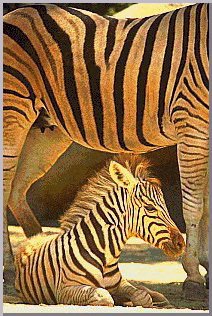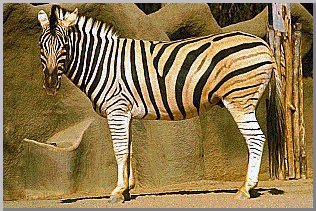
|
|





|







 Name: Damara Zebra
Name: Damara Zebra (Equus burchelli antiquorum)
Home: Grasslands, light woodlands and
savannas, from Angola to the Transvaal
Status in Wild: Secure in range
Foods: Grass
Name: Grevy's Zebra (Equus grevyi)
Home: Southern Ethiopia, Somalia and
Northern Kenya
Status in Wild: Threatened
Foods: Coarse grass
The zebra is a distinctly striped, hoofed mammal in the genus Equus (which includes the horse and the ass) of the family Equidae.
The smooth whitish or tawny coat is marked with striking dark brown or black bands or stripes, which have a distinctive pattern in each of the three species of zebras.
The zebras inhabit open grassy plains and some mountain areas in eastern, central and southern Africa.
Zebras are social animals. They live in small groups, or herds, of
five to 15 animals. A herd is usually made up of several females and
their young, led by an adult male, or stallion. Living in herds is
much safer for zebras than living alone. This is because a group of
zebras has many more eyes and ears to watch and listen for predators.
When two zebras stand side by side, they usually face in opposite
directions. This makes it possible for them to see in all directions -
and makes it twice as easy to spot predators.
Danger lurks everywhere for zebras - even in the water. If one zebra
is in trouble, the others come to its rescue.
Zebras use the expression on their faces to let each other know how they feel about things. An angry zebra pulls back its ears and shows its teeth. Zebras are noisy animals. They talk to each other by braying or barking loudly and they often call to each other when they are separated.
When stalked by a lion or leopard - their natural enemies - zebras can run at speeds up to 60 km/hr (40 mph).
Zebras are herbivorous, eating grass and browsing on shrubs.
A single foal is born in spring. Male babies are called colts and
females are called fillies. A newborn foal weighs 60 to 70 pounds
(27 to 32 kgs) and stands about 3 feet tall (1 m). Its fur is softer
and fuzzier than its mother's and its stripes are sometimes brown and
white, rather than black and white.
When running with the herd, foals always stay close to their mothers
for protection, but other zebras will watch over them too, if
necessary.
Extensive hunting for their skins has reduced the number of zebras. Unsuccessful attempts have been made to domesticate them for use as mounts and work animals and to cross them with horses to produce a draft animal.
 There are three different types of zebras. Though all zebras live in
Africa, one type roams in the semi-deserts, another type lives in the
stony mountains and the last group lives on the plains - the open
grasslands. The plains zebras are the most common type.
The Damara Zebra and other plains zebras are distinguished
by the brownish or grayish shadow stripes that lie between the bolder
stripes.
There are three different types of zebras. Though all zebras live in
Africa, one type roams in the semi-deserts, another type lives in the
stony mountains and the last group lives on the plains - the open
grasslands. The plains zebras are the most common type.
The Damara Zebra and other plains zebras are distinguished
by the brownish or grayish shadow stripes that lie between the bolder
stripes.
Grevy's Zebras is the largest of the zebra species and its
stripes are narrower and closer together than the other species. The
stripes also don't really cover the whole Grevy's zebra. The belly
and the area at the base of the tail don't have any stripes and are
just plain white.
One other way to tell the difference between a Grevy's zebra and
another species is from the ears. A Grevy's zebra has long, wide
and rounded ears.
In the wild, Grevy's zebras live in eastern Africa, where they like
to eat savanna grass.
Go to the top of the page